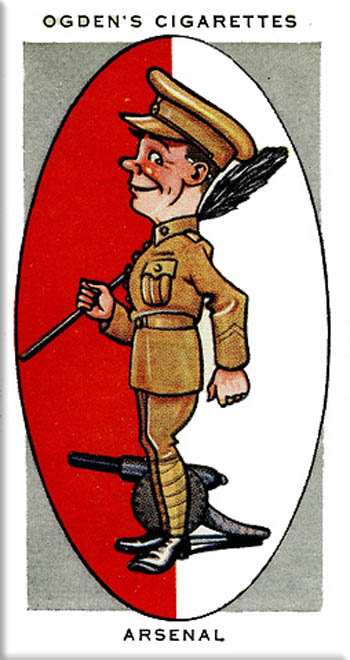Arsenal FC
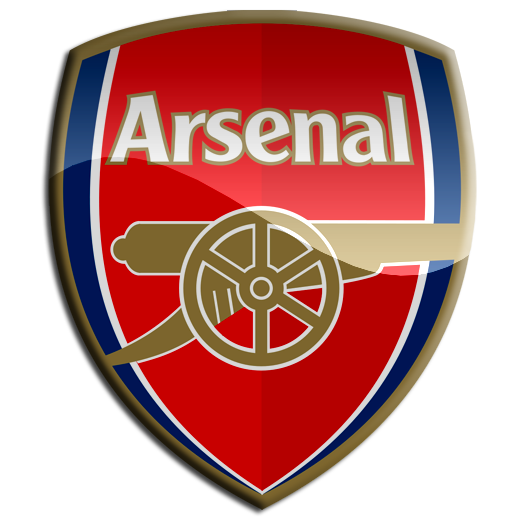
Details
- Name: Arsenal Football Club
- Nickname: The Gunners
- Founded: 1886 (as Dial Square)
- Renamed: 1886 to Royal Arsenal
- Renamed: 1893 to Woolwich Arsenal
- Renamed: 1913 to Arsenal
- Ground: Emirates Stadium
- Ground capacity: 60,338
Arsenals many stadiums
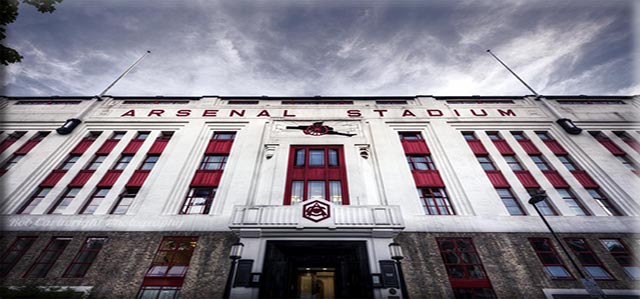
Manor Ground (Plumstead)
Tennants: Royal / Woolwich Arsenal (1888-1890, 1893-1913)
Capacity: 33,000 - Opened: 1888 - Closed: 1913
Under their original name of Dial Square, the club's very first match in December 1886 was on a field in the Isle of Dogs, most likely by Glengall Road (now known as Tiller Road). After that, for the rest of the 1886-87 season, the newly renamed team Royal Arsenal played on Plumstead Common. They moved in September 1887 to a pig field on Plumstead Marshes, which was renamed the Sportsman Ground after the Sportsman pub nearby. They continued to play there for the next six months.
In 1888, after the Sportsman Ground had flooded, the club moved to the adjoining Manor Field (as it was originally known), which was soon renamed Manor Ground. The pitch was notoriously muddy and on its southern side ran a large open sewer. There were no stands as such; the club used wagons borrowed from nearby Army bases to house spectators. The club's first match there was against Millwall Rovers, on 30 March 1888; it finished 3-0 to Arsenal.
In 1890, Royal Arsenal decided to move to the much more suitable Invicta Ground (which possessed a stand, terracing and changing rooms), on the south side of Plumstead High Street. They stayed there for three years (in the meantime changing their name to Woolwich Arsenal, and turning professional), before leaving after the owner of the Invicta raised the rent on the ground. Arsenal bought the Manor Ground with money raised from a share issue, erected a single main stand and banks of terracing, and moved back there before the start of the 1893-94 season, in time for the club's Football League debut. The stadium averaged a gate of 6,000 that season.
Woolwich Arsenal continued to play their home matches at Manor Ground for the next twenty years, with two exceptions. They were forced to stage one league fixture against Burton Swifts at New Brompton's Priestfield Stadium and one against Leicester Fosse at Lyttelton cricket ground, Leyton in 1895; the Manor Ground had been closed by the Football League for a period of five weeks after crowd trouble at a match against Burton Wanderers in January of that year.
In 1904 a second stand was added (this is the earliest known terrace in the country to be nicknamed Spion Kop, although many other clubs, such as Liverpool, also built eponymous stands that were better known). With the club having achieved promotion to the First Division that year, with the additional capacity attendances reached over 20,000 for some matches. However, attendances soon dipped, thanks in no small part to the Manor Ground's relatively isolated location, in an industrial area with few local residents.
After years of financial precarity, in 1910 Woolwich Arsenal faced bankruptcy, with the club managing an average crowd of only 11,000, compared to Chelsea's average gate of 28,000. That year, London property magnate and Fulham chairman Sir Henry Norris bought Arsenal out, rescuing the club, and he proceeded to move them all the way across London to the new Arsenal Stadium in Highbury three years later, after an attempt to merge Fulham and Arsenal failed.
Woolwich Arsenal played their last match at the Manor Ground on 26 April 1913, a 1-1 draw against Middlesbrough watched by only 3,000 people. After they left, the ground soon fell derelict, and was eventually demolished and the land redeveloped. Today it is home to an industrial estate; the stadium's former site is roughly bound by Nathan Way, Griffin Manor Way and Hadden Road. Arsenal's departure was one reason for another local club, Charlton Athletic, to turn professional in 1920 and taking their place as the area's main club.
Invicta Ground
Tenants: Woolwich Arsenal (1890-1893) Royal Ordnance Factories (1893-1894)
Capacity: 12,000 - Opened: 1890 - Closed: 1894
The Invicta Ground was a football stadium in Plumstead, south-east London, that was the home of Royal Arsenal (today known simply as Arsenal) between 1890 and 1893.
Named after Invicta, the motto of the county of Kent (which was the county Plumstead was located in prior to 1889), the ground was Arsenal's first proper stadium, being equipped with a stand, a row of terracing and changing rooms. It stood on the south side of Plumstead High Street; Arsenal's old ground, the Manor Ground, on the opposite side of high street, was by contrast little more than a glorified pig field; the club had used military wagons as makeshift stands for spectators.
When Royal Arsenal first moved to the Invicta Ground, they were an amateur team with a following of only about 1,000, but within a year the club had turned professional and had renamed themselves Woolwich Arsenal. They started to attract much larger crowds, including a record 12,000 for a match against the then Scottish Cup holders Heart of Midlothian on 30 March 1891, which Woolwich Arsenal lost 5–1.
Woolwich Arsenal intended to use the Invicta for 1893–94, their first season playing in the Football League. However, the ground's owner, George Weaver (a mineral water magnate), wishing to make the most out of the rise in Arsenal's fortunes, put the annual rent up from £200 to £350, a sum which the club could not afford. Arsenal returned to the Manor Ground, which they bought outright after a share issue, and spent the summer of 1893 building proper stands and facilities.
An amateur side, Royal Ordnance Factories, set up in response to Woolwich Arsenal joining the League, played some home games in the Invicta Ground; however they had left by late 1894 and Weaver could not find a permanent tenant for the ground. He eventually demolished it, building houses on the site. Today Mineral Street and Hector Street stand where the stadium used to be; some of the stadium's concrete terracing still survives in the back gardens of houses in Hector Street.
The Arsenal Stadium (Highbury)
Tenants: Arsenal F.C. (1913–2006) Capacity38,419 (at closure), 73,000 (peak) Opened: 6th Sep 1913 Closed: 7th May 2006
The original stadium was built in 1913, when Woolwich Arsenal moved from the Manor Ground in Plumstead, South East London to Highbury, leasing the recreation fields of St John's College of Divinity for £20,000. The lease negotiation also agreed that no matches were to be played on "holy days" and that no "intoxicating liquor" would be sold at the stadium, these stipulations were dropped within a year.
The stadium was hurriedly built over the summer of that year, and was designed by Archibald Leitch, architect of many other football grounds of that era. It featured a single stand on the eastern side and the other three sides had banked terracing. The new stadium cost £125,000. It opened whilst not fully complete, with Arsenal's first match of the 1913–14 season, a 2–1 Second Division win against Leicester Fosse on 6 September 1913. Leicester's Tommy Benfield scored the first goal at the new ground while George Jobey was the first Arsenal player to do so. Highbury hosted its first England match in 1920.
The Australian rugby league team suffered the first loss of their 1921–22 Kangaroo tour of Great Britain at Highbury to an English side 4 points to 5 before approximately 12,000 spectators.
Arsenal bought the stadium site outright in 1925, for £64,000.
No significant portion of Leitch's original stadium remains today following a series of bold redevelopments during the 1930s. The idea was to create a ground for London that could capture the grandeur of Villa Park, home of Birmingham club Aston Villa. The Highbury project was ambitious in its scale and reach, the first stand completed being the West Stand, designed by Claude Waterlow Ferrier and William Binnie in the Art Deco style which opened in 1932. On 5 November the same year the local Tube station was renamed from Gillespie Road to Arsenal. Leitch's main stand was demolished to make way for a new East Stand, matching the West, in 1936. The West Stand cost £45,000 while the East Stand went far over budget and ended up costing £130,000, mainly thanks to the expense of the facade. The North Bank terrace was given a roof and the southern terrace had a clock fitted to its front, giving it the name the Clock End.
During the 1948 Summer Olympics, the stadium hosted the football preliminaries. For the next 50 years, the stadium changed little, although during World War II the North Bank terrace was bombed and had to be rebuilt; the roof was not restored until 1956. Floodlights were fitted in 1951, with the first floodlit match being a friendly against Hapoel Tel Aviv on 19 September of that year. The floodlights that adorn Dalymount Park, once stood at the Arsenal stadium. They were shipped to Dublin in 1962. The inaugural floodlit match saw Arsenal beat Bohemians 3–8. Undersoil heating was added in 1964. Unlike at many other grounds, Arsenal refused to install perimeter fencing, even at the height of hooliganism in the 1980s, which made it ineligible for use as an FA Cup semi-final venue.
Before the Taylor Report and the era of all-seater stadiums in Britain, both the North Bank and Clock End consisted of terracing, and the stadium often saw crowds of up to 60,000 or more; its largest attendance was 73,295 on 9 March 1935 when Arsenal played Sunderland in the First Division; the game finished 0–0. When the ground was initially constructed, it was to "accommodate 90,000 spectators".
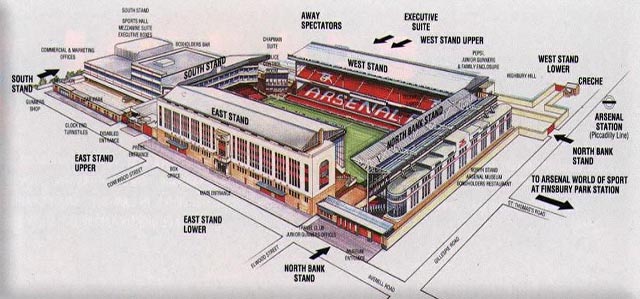
The Clock End was redeveloped in 1988/89 with the addition of a roof and 48 executive boxes, while seating was fitted into the remaining standing area in 1993.
In the early 1990s, the Taylor report on the Hillsborough disaster was published, which recommended that football stadia become all-seater. The North Bank, which had become home of Arsenal's most passionate supporters, was demolished at the end of the 1991–92 season. During redevelopment, a giant mural of fans was placed behind the goal at that end, to give the illusion that the players were kicking towards a crowd rather than a construction site. The mural initially attracted criticism for its absence of black fans, which was quickly rectified. Populous (then LOBB Partnership) designed all-seater two-tier North Bank Stand, the last area of Highbury to be refurbished, which was opened in August 1993 at a cost of £20 million amid strong opposition from local residents.
The new North Bank Stand contained a museum and a concourse with video arcades, bars, confectionery counters, souvenir shops and fast-food stands. The old stand had received a fitting send off with a 5–1 defeat of Southampton, though the new stand had a less auspicious start, the first game being a surprise 0–3 defeat to Coventry City with all 3 goals coming from striker Micky Quinn. The first victory came 10 days later against Leeds United.
At the time of its closure, the stadium consisted of four separate all-seater stands; the pitch was aligned north-south, with the North Bank Stand (formerly the Laundry End) and South Stand (popularly known as the Clock End) at the ends of the field. The East and West Stands ran alongside the pitch and are two of the few examples of British football stands designed in the Art Deco style.
The East Stand incorporated the club's offices and was well known for its marble halls (though the floors were actually terrazzo) which are often cited in media depictions of the stadium, and the facade that faces onto Avenell Road. The East Stand is considered architecturally significant enough to have been designated a Grade II listed building.
The stadium's main entrances were on Gillespie Road, Avenell Road and Highbury Hill. When it closed, Highbury had a capacity of 38,419 (approximately 12,500 in the North Bank, 11,000 in the West Stand, 9,000 in the East Stand and 6,000 in the Clock End), all seated, and had Jumbotron screens in the south-east and north-west corners.
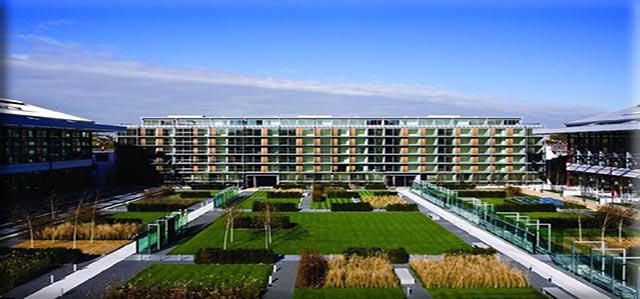
Closure and redevelopment into accomodation
The post-Taylor capacity of Highbury was limited to 38,419, while Arsenal's success during the 1990s and 2000s meant that virtually every home match was filled to near capacity. Restrictions, such as the East Stand's status as a listed building and the fact the stadium was surrounded on all sides by a residential area, made any future expansion of Highbury difficult and expensive. Eventually Arsenal decided to leave Highbury and construct a new stadium, the Emirates Stadium in nearby Ashburton Grove, which opened in July 2006. Arsenal's offices were moved to a new building, Highbury House, which was named in commemoration of the former stadium.
For their final season at Highbury (2005–06) Arsenal ran a series of promotions honouring the stadium's legacy. A commemorative logo was designed featuring the club's traditional Art Deco crest from the 1930s, and the club's history at Highbury was celebrated through a series of themed matchdays. On the field, Arsenal temporarily set aside their traditional red shirts with white sleeves for the season and adopted a solid redcurrant shirt, the colour they wore during their first season at Highbury in 1913–14.
Arsenal's final game at the stadium was their FA Premier League match on 7 May 2006 against Wigan Athletic, the last game of the season. The team needed to better the result of neighbours Tottenham Hotspur to again secure qualification for the Champions League. Having been 2–1 behind, a hat trick by captain and all-time leading goal scorer Thierry Henry secured qualification, with Henry kneeling down to kiss the turf on scoring what proved to be the final goal seen at the stadium.
The last goal scored in a regulation game at the stadium came in a Football Aid charity match when lifelong fan Alan Alger scored a penalty in the final minute of a fixture played on Thursday 8 June 2006 (exactly one month and one day after Henry's goal). After the stadium's closure, Arsenal held an auction to sell off many of the stadium's parts, including pieces of the pitch, the goalposts and former manager George Graham's desk. Sale of the stadium's seats had to be cancelled after it was found they contained trace amounts of the toxic metal cadmium.
As of 2010, Arsenal Stadium was redeveloped and converted into flats in a project known as "Highbury Square", a scheme that had 711 properties built on the site. The North Bank and Clock End stands were demolished. The exteriors of the listed Art Deco East Stand and the matching West Stand were preserved and incorporated into the new developments, while the rest of the stands' structures were removed, and the pitch became a communal garden. In October 2005 the proposed flats went on sale; as of May 2006 all properties in the North, East and West Stands had been taken.
Arsenal's famous clock was moved from Highbury to the outer side of the new stadium, with a new larger version of the feature added inside the ground in August 2010. At the same time as the unveiling of the new clock, the south stands at the venue were also renamed Clock End inline with the same name previously used at Highbury.
The Emirates Stadium
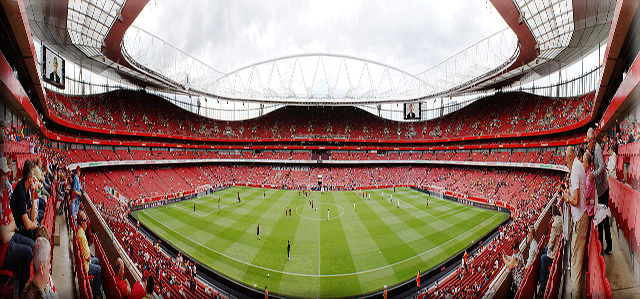
Tenants: Arsenal F.C. Capacity 60,272 Opened: 22nd July 2006
The Emirates Stadium is a football stadium in Holloway, London, England, and the home of Arsenal Football Club. With a capacity of 60,272, the Emirates is the third-largest football stadium in England after Wembley and Old Trafford.
In 1997, Arsenal explored the possibility of relocating to a new stadium, having been denied planning permission by Islington Council to expand its home ground of Highbury. After considering various options (including purchasing Wembley), the club bought an industrial and waste disposal estate in Ashburton Grove in 2000.
A year later they won the council's approval to build a stadium on the site; manager Arsène Wenger described this as the "biggest decision in Arsenal's history" since the board appointed Herbert Chapman. Relocation began in 2002, but financial difficulties delayed work until February 2004. Emirates Airline was later announced as the main sponsor for the stadium. Work was completed in 2006 at a cost of £390 million.
The stadium has undergone a process of "Arsenalisation" since 2009 with the aim of restoring Arsenal's heritage and history. The ground has hosted music concerts and international fixtures featuring Brazil.
For more details on this stadium, see History of Emirates Stadium
Honours
- First Division (until 1992) and Premier League
- Winners (13): 1930–31, 1932–33, 1933–34, 1934–35, 1937–38, 1947–48, 1952–53, 1970–71, 1988–89, 1990–91, 1997–98, 2001–02, 2003–04
- FA Cup
- Winners (11): 1929–30, 1935–36, 1949–50, 1970–71, 1978–79, 1992–93, 1997–98, 2001–02, 2002–03, 2004–05, 2013–14, 2014-15, 2016-17, 2019-20
- League Cup
- Winners (2): 1986–87, 1992–93
- FA Community Shield (FA Charity Shield before 2002)
- Winners (13): 1930, 1931, 1933, 1934, 1938, 1948, 1953, 1991 (shared), 1998, 1999, 2002, 2004, 2014
- Mercantile Credit Centenary Trophy
- Winners (1): 1988–89
- European Cup Winners' Cup
- Winners (1): 1993–94
- Inter-Cities Fairs Cup
- Winners (1): 1969–70

Mikel Arteta
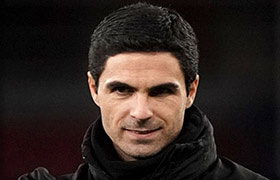
The Facts
Arsenal Football Club are a Premier
League football club based in Holloway,
London.
One of the most successful clubs in
English football, they have won 13 First
Division and Premier League titles and
a joint record 11 FA Cups.
Arsenal's success has been
particularly consistent: the club has
accumulated the second most points in
English top-flight football, holds the
ongoing record for the longest
uninterrupted period in the top flight, and
would be placed first in an aggregated
league of the entire 20th century.
Arsenal are the second side to
complete an English top-flight season
unbeaten (in the 2003–04 season), doing
so under almost twice the matches of the
previous team.
Arsenal were founded in 1886 in
Woolwich and in 1893 became the first
club from the south of England to join the
Football League. In 1913, they moved
north across the city to Arsenal Stadium in
Highbury. In the 1930s, they won five
League Championship titles and two
FA Cups.
After a lean period in the post-war
years they won the League and FA Cup
Double in the 1970–71 season, and in the
1990s and first decade of the 21st century,
won two more Doubles and reached the
2006 UEFA Champions League Final.
Since neighbouring Tottenham Hotspur,
the two clubs have had a fierce rivalry, the
North London derby.
Arsenal has one of the highest incomes
and largest fanbases in the world.
Forbes's 2014 estimate put Arsenal as the
5th most valuable association football club in
the world, valued at more than $1.3 billion.
For further information check out their Official website or their Fan Forum
The History
Arsenal Football Club were formed as Dial Square in 1886 by workers at the Royal Arsenal in Woolwich, south-east London, and were renamed Royal Arsenal shortly afterwards. The club was renamed again to Woolwich Arsenal after becoming a limited company in 1893.
The club became the first southern member of the Football League in 1893, starting out in the Second Division, and won promotion to the First Division in 1904. The club's relative geographic isolation resulted in lower attendances than those of other clubs, which led to the club becoming mired in financial problems and effectively bankrupt by 1910, when they were taken over by businessmen Henry Norris and William Hall.
Norris sought to move the club elsewhere, and in 1913, soon after relegation back to the Second Division, Arsenal moved to the new Arsenal Stadium in Highbury, North London; they dropped "Woolwich" from their name the following year. Arsenal only finished in fifth place in the second division during the last pre-war competitive season of 1914–15, but were nevertheless elected to rejoin the First Division when competitive football resumed in 1919–20, at the expense of local rivals Tottenham Hotspur. Some books have reported that this election to division 1 was achieved by dubious means.
Arsenal appointed Herbert Chapman as manager in 1925. Having already won the league twice with Huddersfield Town in 1923–24 and 1924–25 (see Seasons in English football), Chapman brought Arsenal their first period of major success. His revolutionary tactics and training, along with the signings of star players such as Alex James and Cliff Bastin, laid the foundations of the club's domination of English football in the 1930s.
Under his guidance Arsenal won their first major trophies – victory in the 1930 FA Cup Final preceded two League Championships, in 1930–31 and 1932–33. In addition, Chapman was behind the 1932 renaming of the local London Underground station from "Gillespie Road" to "Arsenal", making it the only Tube station to be named specifically after a football club.
Chapman died suddenly of pneumonia in early 1934, leaving Joe Shaw and George Allison to carry on his successful work. Under their guidance, Arsenal won three more titles, in 1933–34, 1934–35 and 1937–38, and the 1936 FA Cup while also becoming known as the "Bank of England club." As key players retired, Arsenal had started to fade by the decade's end, and then the intervention of the Second World War meant competitive professional football in England was suspended.
After the war, Arsenal enjoyed a second period of success under Allison's successor Tom Whittaker, winning the league in 1947–48 and 1952–53, and the FA Cup in 1950. Their fortunes waned thereafter; unable to attract players of the same calibre as they had in the 1930s, the club spent most of the 1950s and 1960s in trophyless mediocrity. Even former England captain Billy Wright could not bring the club any success as manager, in a stint between 1962 and 1966.
Arsenal began winning silverware again with the surprise appointment of club physiotherapist Bertie Mee as manager in 1966. After losing two League Cup finals, they won their first European trophy, the 1969–70 Inter-Cities Fairs Cup. This was followed by an even greater triumph: their first League and FA Cup double in 1970–71. This marked a premature high point of the decade; the Double-winning side was soon broken up and the following decade was characterised by a series of near misses, starting with Arsenal finishing as FA Cup runners up in 1972, and First Division runners-up in 1972–73.
Terry Neill was recruited by the Arsenal board to replace Bertie Mee on 9 July 1976 and at the age of 34 he became the youngest Arsenal manager to date. With new signings like Malcolm Macdonald and Pat Jennings, and a crop of talent in the side such as Liam Brady and Frank Stapleton, the club enjoyed their best form since the 1971 double, reaching a trio of FA Cup finals (1978, 1979 and 1980), and losing the 1980 European Cup Winners' Cup Final on penalties. The club's only success during this time was a last-minute 3–2 victory over Manchester United in the 1979 FA Cup Final, widely regarded as a classic.
The return of former player George Graham as manager in 1986 brought a third period of glory. Arsenal won the League Cup in 1987, Graham's first season in charge. This was followed by a League title win in 1988–89, won with a last-minute goal in the final game of the season against fellow title challengers Liverpool.
Graham's Arsenal won another title in 1990–91, losing only one match, won the FA Cup and League Cup double in 1993, and a second European trophy, the European Cup Winners' Cup, in 1994. Graham's reputation was tarnished when he was found to have taken kickbacks from agent Rune Hauge for signing certain players, and he was dismissed in 1995. His replacement, Bruce Rioch, lasted for only one season, leaving the club after a dispute with the board of directors.
The club's success in the late 1990s and first decade of the 21st century owed a great deal to the 1996 appointment of Arsène Wenger as manager. Wenger brought new tactics, a new training regime and several foreign players who complemented the existing English talent.
Arsenal won a second League and Cup double in 1997–98 and a third in 2001–02. In addition, the club reached the final of the 1999–2000 UEFA Cup (losing on penalties to Galatasaray), were victorious in the 2003 and 2005 FA Cups, and won the Premier League in 2003–04 without losing a single match, an achievement which earned the side the nickname "The Invincibles". The feat came within a run of 49 league matches unbeaten from 7 May 2003 to 24 October 2004, a national record.
Arsenal finished in either first or second place in the league in eight of Wenger's first eleven seasons at the club, although on no occasion were they able to retain the title. As of July 2013, they were one of only five teams, the others being Manchester United, Blackburn Rovers, Chelsea, and Manchester City, to have won the Premier League since its formation in 1992.
Arsenal had never progressed beyond the quarter-finals of the Champions League until 2005–06; in that season they became the first club from London in the competition's fifty-year history to reach the final, in which they were beaten 2–1 by Barcelona. In July 2006, they moved into the Emirates Stadium, after 93 years at Highbury.
Arsenal reached the final of the 2007 and 2011 League Cups, losing 2–1 to Chelsea and Birmingham City respectively. The club had not gained a major trophy since the 2005 FA Cup until 17 May 2014, when Arsenal beat Hull City in the 2014 FA Cup Final, coming back from a 2–0 deficit to win the match 3–2. Arsenal won the FA Cup again the following season 2014-15, and once again at the end of the 2016-17 season, making them the most successful club in FA Cup history.
Arsene Wenger announced the 2017-18 season would be his last at Arsenal, and on 23rd May 2018, Unai Emery was confirmed as Arsenal manager.
On Friday 29th November 2019, Emery was relieved of his duties, and Freddie Ljungberg took temporary responsibility for the first team as interim head coach.
On Friday 21st December 2019, Arsenal announced they had hired Mikel Arteta on a 3 1/2 year deal, officially taking over on the Sunday.
On Saturday 1st August 2020, Arteta lead Arsenal to a record 14th F.A Cup victory beating Chelsea 2-1 in the final.
For more details on this topic, see History of Arsenal F.C. (1886–1966) and History of Arsenal F.C. (1966–present)
Notable Players
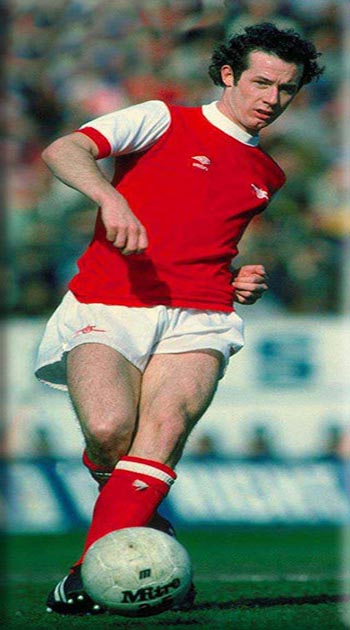
Liam Brady - Arsenal 1973 - 1980
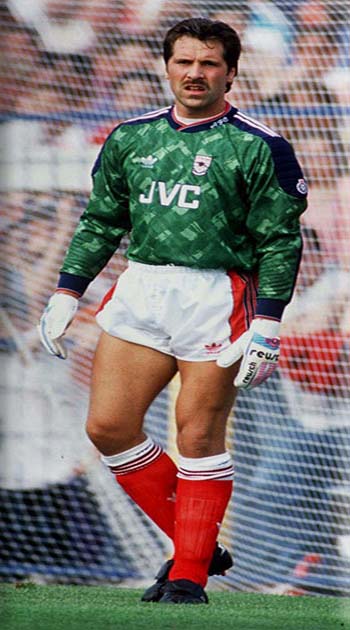
David Seaman - Arsenal - 1990 - 2003

Thierry Henry - Arsenal 1999 - 2007
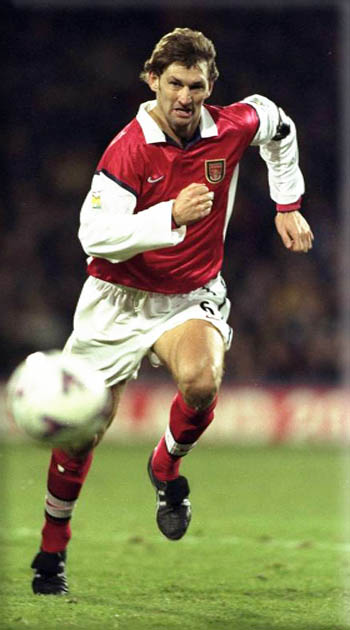
Tony Adams - Arsenal - 1983 - 2002
Miscellaneous
